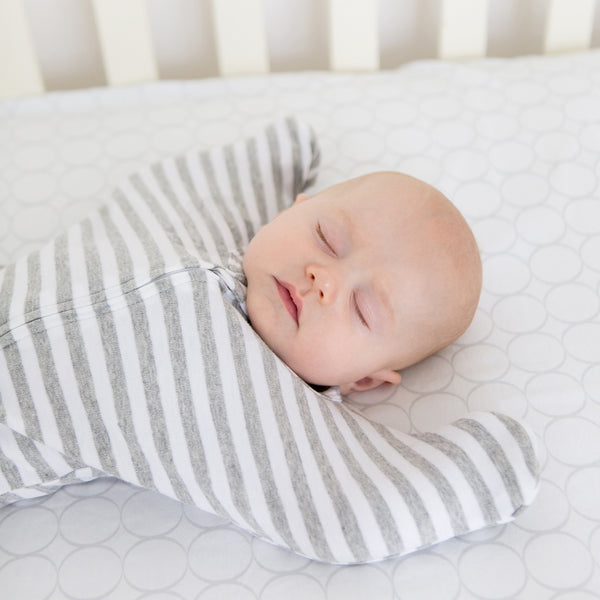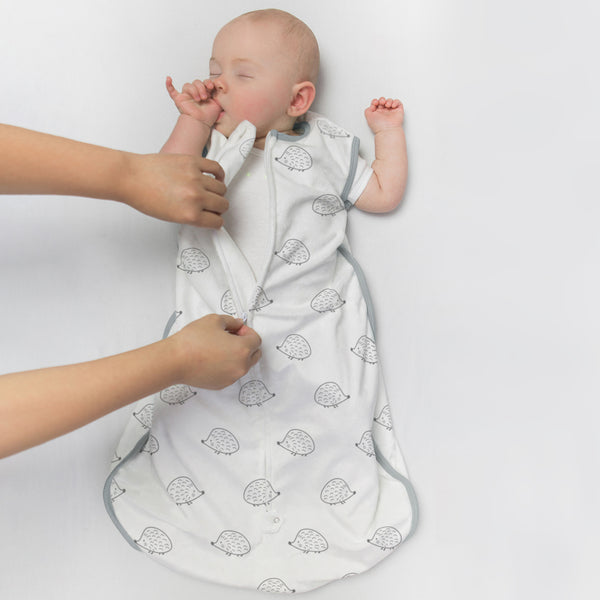Research has shown when a baby becomes overly chilled or overheated it is a serious medical situation, and both insufficient thermal insulation and overheating have been linked to SIDS, as stated in the International Journal of Epidemiology and The Journal of Pediatrics.
Continued education is important to help reduce the incidence of SIDS and sharing correct information is of utmost importance.

It is important to remind parents and caregivers that it is a paramount responsibility to dress baby appropriately based on the current temperature of their environment and to adjust baby’s clothes as the temperature changes, and to touch and feel their baby to make sure that baby is not overly warm or overly chilled. Parents need to understand that no blanket and no product can naturally regulate their baby’s temperature.
Getting too warm is as likely as getting too cold, so parents must continue to monitor, touch and feel their baby to ensure baby is not too hot or too cold, because both overchilling and overheating are SIDS risk factors and can impact the health and well being of infants.
Deep sleep makes baby more vulnerable both to cold and heat, so when baby settles into sleep caregivers need to check their baby. It is an important responsibility of the caregiver to dress baby appropriately for sleep based on the temperature of their environment. Parents should not underdress or overdress their baby for sleep. Parents should not rely on commercial monitors as per the AAP.
As a general guide, the American Academy of Pediatrics recommends dressing baby in no more than one layer more than an adult would use to be comfortable in the same environment, Baby’s head should be uncovered, while indoors once you're home from the hospital.

Parents and caregivers should touch baby’s chest, tummy or back to feel if baby is too hot or too cold. Baby’s tummy and chest should feel warm and dry, not sweaty or cold.Baby's temperature can be assessed with reasonable precision by human touch. Abdominal temperature is representative of the core temperature and it is reliable in the diagnosis of hypothermia.For many years it was considered okay if baby's hands and feet were cool. The belief was the coolness was due to baby's immature circulatory system. However, recently, the World Health Organization states that baby's hands and feet should be pink and warm.Warm and pink feet of the baby indicate that the baby is in thermal comfort. But when feet are cold and trunk is warm it indicates that the baby is in cold stress. In hypothermia both feet and trunk are cold to touch.Babies need to be comfortably warm. If they are just starting to get too warm or too cold they will often get fussy. Keep baby nearby to parents and caregivers, so they may respond and check on baby if baby becomes fussy.

Signs of Chilling
A baby who is not able to stay warm and is losing the battle to stay warm and is in danger of being chilled will become very quiet and still. Babies are not able to shiver like adults to generate heat. Babies that are too cold will not exert the energy it takes to cry, and may be uninterested in feeding. Their energy is being consumed by trying to stay warm. A baby that is dangerously chilled will have cold hands and feet and even baby’s chest will be cold under his or her clothes. This baby is already too cold and cannot make enough warmth for his or herself and should be held close to an adult body to warm baby. After baby is warm, extra layers or an appropriate covering may be added.
If such a baby were given no help in getting warm, baby could slip into the next stage of chilling which is called the neonatal cold syndrome. Vital body functions run very slowly and baby is lethargic, floppy and difficult to arouse. Baby’s hands and feet look swollen and bright pink and skin will feel very cold. This baby needs urgent medical attention and will need to be warmed slowly.
Signs of Overheating
A baby who is overly warm may have damp hair, a sweaty back and chest, red ears, a rapid pulse and sometimes fever. A layer of clothing should be removed and baby may need to be taken to a cooler environment or gently fanned.
A baby that is excessively overdressed for the current temperature of the environment is at risk for heatstroke which includes the following signs: A sudden rise in body temperature over 100 degrees F, hot dry skin, flushed or pale skin tone, rapid pulse, vomiting, rapid breathing, sluggishness, non-responsiveness, signs of dehydration. This baby needs urgent medical attention and layers of baby’s clothing should be removed. Oral fluids should be encouraged and baby should be sponged with tepid water.
Parents and caregivers need to be aware that no blanket or product can naturally regulate a baby’s temperature. It is an important responsibility of the parents and caregiver to dress their baby appropriately according to the current temperature of their environment. Parents should not overdress or underdress baby. As a general guide the American Academy of Pediatrics recommends dressing baby in no more than one layer more than an adult would use to be comfortable in the same environment.
Most medical experts recommend a sleep environment of 65-72 degrees F. If parents use central air or heat they should set the thermostat for this temperature range and dress the baby in no more than one layer more than an adult would use to be comfortable, and then touch baby’s chest, back or abdomen to ensure baby is not too hot or too cold.
Even though we describe temperature awareness with babies as the Goldilocks Guide – not too hot, not too cold, but just right - when it comes to babies, temperature awareness is important and serious business.
How old is your baby?
Sources:
Williams SM, et al. Sudden Infant Death Syndrome: Insulation from Bedding and Clothing and its Effect Modifiers. International Journal of Epidemiology 1996; 25, 366-75
Beal S, Porter C. Sudden infant death syndrome related to climate. Acta Ped Scanda 1991;80:278-87







